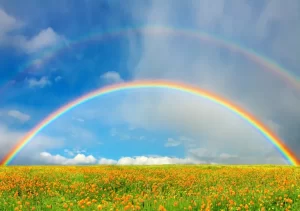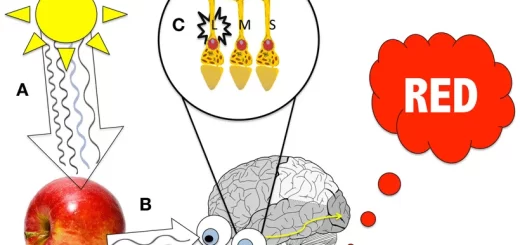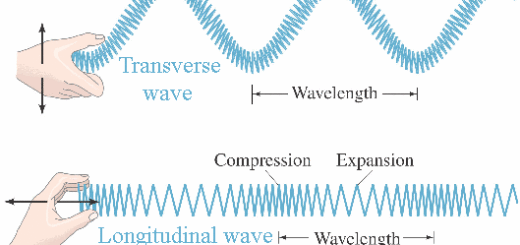Formation of Rainbows, What are the different types of rainbows?
A group of refractions and reflections of sun rays occurs when the sun is incident on the water drops or snow crystals suspended in the air leading to analyzing the light into a bow of spectrum colours known as the rainbow.
Rainbow
The light coming out the back of the raindrop does not create a rainbow between the observer and the sun because the spectra emitted from the back of the raindrop do not have the maximum intensity as the other visible rainbows, and the colours blend together rather than forming a rainbow.
Rainbows are beautiful optical phenomena that occur when light is refracted, reflected, and dispersed in water droplets, usually after a rain shower. Rainbows have various meanings in different cultures, often symbolizing hope, promise, and beauty. In many mythologies, they are seen as bridges between realms or messages from the divine.
The most familiar type of rainbow is produced when the sunlight strikes the raindrops in front of a viewer at a precise angle (42 degrees), and the rainbows can also be viewed around the fog, the sea spray, or the waterfalls. While rainbows are seen as arcs, they are full circles. The ground usually obstructs the bottom half, but in certain conditions, such as viewing from a high altitude, a complete circle can be observed!
When the sunlight hits a rain droplet, some of the light is reflected, The electromagnetic spectrum is made of light with many different wavelengths which are reflected at different angles, the spectrum is separated producing a rainbow, and the colors of the rainbow are red, orange, yellow, green, blue, indigo, and violet.
Formation of Rainbows
- Refraction: As light enters a water droplet, it bends, changing direction because of the difference in density between air and water.
- Reflection: Some of the light reflects off the inside surface of the droplet.
- Dispersion: The light is dispersed into its component colors (red, orange, yellow, green, blue, indigo, violet) because different wavelengths of light bend at slightly different angles.
- Refraction Again: As the light exits the droplet, it refracts again, spreading out the colors to form a circle of light.
Types of rainbow
The primary rainbows that we see all of the time, are the most commonly seen in the sky, they form 40 to 42 degrees of anti-solar point (an imaginary point opposite to the sun) These are the normal red to violet arcs that we see after it rains, if there are smaller reflective droplets, only violet color will be visible.
Primary Rainbow is the most common type, it forms when sunlight is refracted, reflected, and dispersed in water droplets. It appears as a spectrum of colors (red on the outside, violet on the inside). The primary Rainbow is the standard rainbow with the classic color order. The sequence of colors in a primary rainbow is always the same, starting from red on the outer edge and ending with violet on the inner edge.
Secondary rainbows are caused by a double reflection of sunlight inside the raindrops, and they are centered on the sun itself, they are reflected twice inside of the raindrop, and they have the colors reversed and appear next to the primary rainbow, they appear to be higher than the primary, they are known as Alexanders Dark Band.
A secondary rainbow is a fainter rainbow that appears outside the primary rainbow, caused by light reflecting twice within water droplets. It has the colors in reverse order (red on the inside).
The Spurious or Supernumerary bows are faint color arcs that are sometimes seen next to the primary or secondary bow, they need the interference of light rays of different wavelengths to be formed, and the faint pastel streaks of colour also form outside the secondary rainbow through it is rare.
The supernumerary rainbows are known as the stacker rainbows, The alternating faint rainbows are caused by interference between rays of light following slightly different paths with slightly varying lengths within the raindrops, The Interference is responsible for the lighter hues and narrower bands of supernumeraries. Supernumerary Rainbows are Faint, closely spaced bands inside the primary rainbow due to light interference.
The fogbows or the white rainbows are not formed by the rain but due to the fog, they are formed by much smaller cloud and fog droplets that diffract the light, They are almost white with faint reds on the outside and blues inside. Fogbow is formed in fog rather than rain, it appears as a white arc with very weak colors due to smaller water droplets.
When the water droplets are too tiny for the light to pass through in the same manner as in a normal rainbow, the dispersion of light takes place, it results in white bands and circles of light that are sometimes seen in the clouds, they are known as Fogbows.
Lunar Rainbows are not formed by the sunlight but due to the moonlight, they are formed when the moon emits the white light that the raindrops can refract and reflect into the atmosphere. A moonbow is a rainbow created by moonlight instead of sunlight, typically appearing white due to the lower intensity of moonlight.
The lunar rainbows are also called the moonbows, they appear on the lunar month when the moon is nearly full, they are formed as a white arc or a white faint bow on the outer rim of the moon, the moonlight is much fainter than the sunlight so the lunar rainbows are not bright.
Red Rainbows or Monochrome rainbows occur at sunset or sunrise when the light travels far distance to reach the water drops, where the shorter wavelengths like blue and green have been scattered, and only the red light (that has a long wavelength) emerges from the raindrop forming the red arcs of light, So it is visible in this rainbow. Red Rainbow is a phenomenon that occurs when the sun is low in the sky, making the rainbow predominantly red, often seen at sunrise or sunset.
A double rainbow is caused when the light is reflected twice inside the raindrop, it is A secondary rainbow appears above the primary one, and the spectrum of the secondary rainbow is reversed in that red is on the inner section of the arch, while violet is on the outside. Twinned Rainbow: Two primary rainbows that appear side by side, created by specific atmospheric conditions.
You can see Mist bows in your garden hose, Surf Bows that occur at the beach, The tertiary rainbows that appear to a viewer facing the sun, They are third-order rainbows, the third reflection of light, and their spectrum is the same as the primary rainbow.
The quaternary rainbows are the fourth-order rainbows, They also appear to the viewers facing the sun, And they are even fainter and broader than the tertiary rainbows.
The Twinned Rainbow is two distinct rainbows that are produced from a single endpoint, They are the result of the light hitting an air mass with different sizes and shapes of water droplets.
You can subscribe to Science Online on YouTube from this link: Science Online
You can download the Science Online application on Google Play from this link: Science Online Apps on Google Play
Dispersion of White light analysis, Normal prism, and thin prism
The nature of light waves and analysis of white light
The regular reflection and irregular reflection of light





i love rainbows.